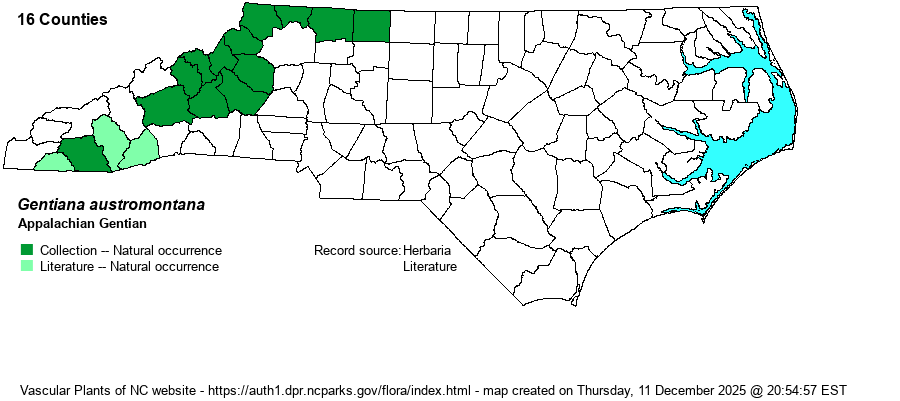| Author | J.S. Pringle & Sharp | |
| Distribution | Nearly throughout the Mountains, though perhaps absent from southwestern counties close to the TN border. Also ranges into the Sauratown Mountains (Hanging Rock State Park).
This is a Southern Appalachian endemic, ranging from western VA and WV south only to western NC and adjacent northeastern TN. Apparently absent in southeastern TN and adjacent southwestern NC near the state line.
| |
| Abundance | Infrequent to fairly common in the northern and central Mountains, south to Buncombe County. Probably rare to uncommon in the southern Mountains, and rare in the Sauratown Mountains. The NCNHP considers this as a Watch List species, though its State Rank of S2S3 is clearly too conservative, considering the large number of specimens from many locales, and its range encompassing at least 16 counties. The website editors feel that no listing is necessary, and assign a State Rank of S3. | |
| Habitat | This is a species of moderate to high elevations, mainly found in high elevation forests, such as Northern Hardwood Forests and High Elevation Red Oak Forests, as well as in grassy balds. | |
| Phenology | Blooms from August to October and fruits shortly after flowering. | |
| Identification | This is a gentian with hairy stems, lanceolate to ovate stem leaves, with acuminate tips. In this species, the calyx lobes are densely pubescent, versus glabrous in G. clausa and G. latidens. The flowers, rich blue to violet-blue, are closed at the tip, as are the other two, as opposed to the widespread G. decora, which has the tube somewhat opened at the tip. To identify this species, check to see if the stems are strongly hairy (decora and austromontana) or smooth (clausa and latidens). G. decora also has calyx lobes that are linear to subulate (extremely slender), 4 times or more as long as broad; G. austromontana has calyx lobes wider, as do others, with the lobes mostly 1-4 times as long as broad. To find this species, head to high elevation balds and forests, and look for a deep blue-flowered gentian. But, as there are quite a few species of gentians in the higher mountains, you will need to check stem and calyx characters carefully. Weakley (2018) states: "The flowers of G. austromontana are usually a deeper and more intense blue-violet than the similar G. clausa and G. decora." | |
| Taxonomic Comments | Though not listed in RAB (1968), Weakley (2018) indicates that this species was subsumed within G. clausa. This is somewhat odd in that the species was first described in 1964.
| |
| Other Common Name(s) | Southern Mountain Gentian | |
| State Rank | S2S3 [S3] | |
| Global Rank | G3 | |
| State Status | W1 | |
| US Status | | |
| USACE-agcp | | |
| USACE-emp | | |

